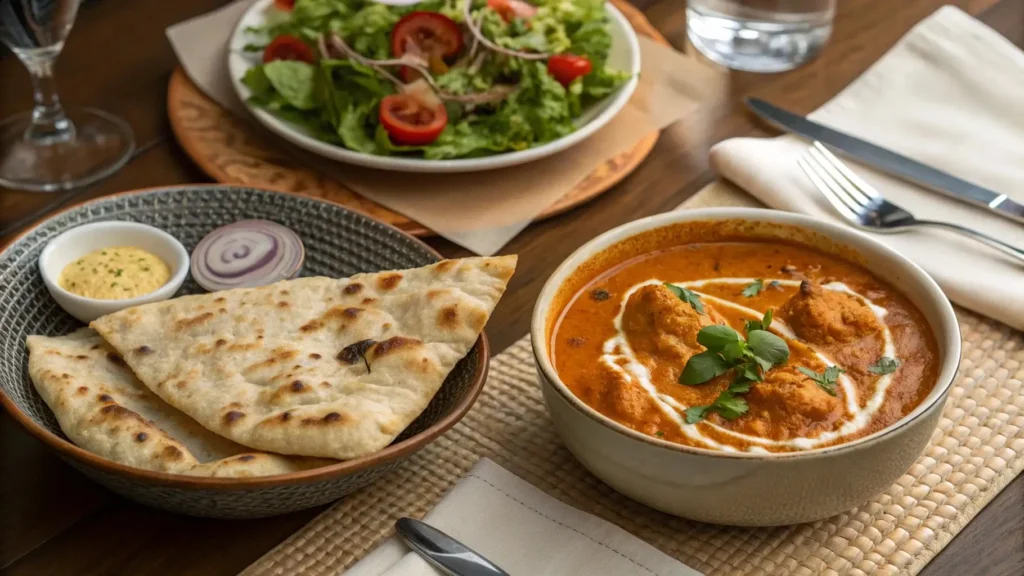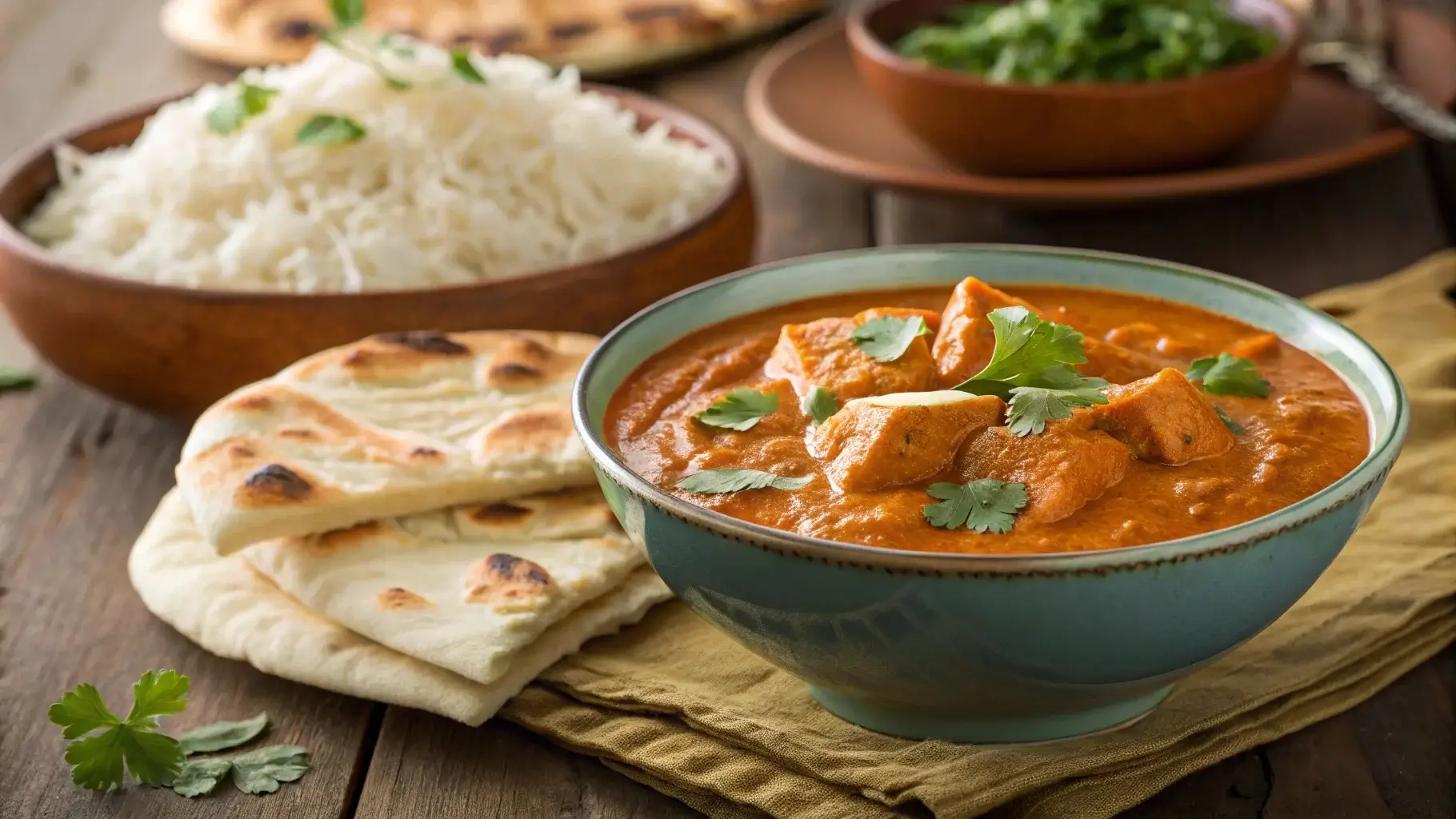Butter masala, a rich and creamy Indian dish, has earned its place as a global favorite. With its silky texture and bold flavors, it’s often seen on restaurant menus and homemade dinner tables alike. But when it comes to health, questions often arise: Is butter masala healthy? While it offers certain nutrients, its high calorie and fat content can make it a questionable choice for those watching their diet. In this article, we’ll explore what makes butter masala so popular, its nutritional profile, potential benefits, concerns, and ways to enjoy a healthier version of this beloved dish. Let’s dive in!
Table of contents
Understanding Butter Masala
What is Butter Masala?
Butter masala is a classic North Indian curry known for its rich, creamy tomato-based sauce. Traditionally, it’s made with ingredients like butter, cream, cashews, and aromatic spices such as turmeric, coriander, and garam masala. Depending on your choice of protein—chicken, paneer, or tofu—it can vary slightly in flavor and texture. The result is a dish that’s indulgent, comforting, and absolutely irresistible.
Common Ingredients in Butter Masala
The foundation of butter masala lies in its ingredients. Tomatoes provide the tangy base, while butter and cream contribute to its signature richness. Cashews or almonds are often added to thicken the sauce, giving it a smooth and luscious consistency. Spices like cumin and cinnamon add warmth, while a touch of sugar balances the flavors.
Why is Butter Masala Popular?
Its universal appeal lies in its versatility and balance of flavors. Butter masala pairs well with naan, rice, or even quinoa, making it a versatile dish for any occasion. Moreover, it’s a crowd-pleaser, easily adapting to various proteins and dietary preferences. However, its luxurious ingredients often raise the question, “Is butter masala healthy?”, leading many to seek answers about its nutritional value and potential impacts on their diet.
Nutritional Profile of Butter Masala
Caloric Content and Serving Sizes
One of the first questions people ask is, “Is butter masala healthy?” The answer often depends on portion size. Butter masala is a calorie-dense dish, with a typical serving containing anywhere between 300 to 450 calories, depending on the ingredients and protein choice. Paneer and chicken are popular options, each adding their own nutritional benefits. However, the butter and cream that give the dish its richness also contribute significantly to its calorie and fat content.
For those watching their calorie intake, eating smaller portions or pairing butter masala with lighter sides like steamed vegetables can help maintain balance.
Key Nutrients Found in Butter Masala
Despite its indulgent reputation, butter masala does have some nutritional upsides. The tomatoes in the sauce are rich in vitamin C, potassium, and antioxidants, which support heart health and boost immunity. Cashews or almonds, often used to thicken the sauce, provide healthy fats, magnesium, and a dose of protein.
The inclusion of spices like turmeric and cumin adds anti-inflammatory properties to the dish. These spices not only enhance the flavor but also offer health benefits, making butter masala more than just a comfort food.
Analyzing Fat, Protein, and Carbohydrate Levels
While butter masala offers some protein, especially when made with paneer or chicken, its fat content is relatively high. A significant portion of this fat comes from saturated fats found in butter and cream. Carbohydrates mainly come from the tomatoes and any added sugar, which helps balance the tanginess of the sauce. Overall, moderation is key to enjoying the nutritional benefits without overloading on calories or fat.

Health Benefits of Butter Masala
Rich Source of Protein
When made with protein-rich ingredients like chicken or paneer, butter masala becomes a good source of high-quality protein. Protein is essential for muscle repair, immune function, and overall energy levels. For vegetarians, paneer butter masala is an excellent way to include protein in their diet without relying on meat.
Contains Antioxidant-Rich Ingredients
Butter masala features antioxidant-packed ingredients, particularly tomatoes. Lycopene, a powerful antioxidant found in tomatoes, helps combat free radicals in the body and supports skin health. The spices used in butter masala, such as turmeric and coriander, further boost its antioxidant content, potentially reducing inflammation and supporting overall well-being.
Potential Benefits of Cashews and Tomatoes
Cashews, a key ingredient in butter masala, are a great source of healthy fats, magnesium, and zinc. These nutrients promote heart health, support brain function, and contribute to better skin. Tomatoes, on the other hand, provide a natural source of vitamins and minerals while being low in calories.
While butter masala is undoubtedly indulgent, its carefully chosen ingredients offer a range of health benefits, especially when consumed in moderation. So, is butter masala healthy? The answer lies in how it’s prepared and enjoyed.
Potential Health Concerns
High Fat and Calorie Content
Butter masala is undoubtedly rich in flavor, but it’s also heavy on calories and fat. The butter, cream, and cashews that give the dish its creamy texture and luxurious taste are high in saturated fats. Regular consumption of high-fat dishes can contribute to weight gain and elevate cholesterol levels, which raises concerns about heart health. So, if you’re wondering, “Is butter masala healthy?”, the answer depends heavily on portion size and frequency of consumption.
Sodium Levels and Portion Control
Another potential concern is the sodium content in butter masala. Many recipes and restaurant versions include a generous amount of salt to enhance the flavor. Consuming too much sodium can lead to issues like high blood pressure and water retention. Portion control is key—enjoy butter masala occasionally and balance it with lighter sides to manage overall sodium intake.
Can It Fit Into a Balanced Diet?
The good news is, butter masala can still be part of a balanced diet when enjoyed in moderation. Pairing it with whole-grain bread like roti or brown rice, and adding a side of vegetables, can help balance its richness. Choosing healthier preparation methods, such as reducing the butter or cream, can also make a big difference.
Healthier Variations of Butter Masala
Using Low-Fat Alternatives
For those who love butter masala but want to make it healthier, low-fat substitutes are an excellent choice. Replace heavy cream with Greek yogurt or low-fat milk to cut down on saturated fats. Similarly, use less butter or switch to heart-friendly oils like olive oil for cooking.
Reducing Butter and Cream
Another simple tweak is to reduce the overall quantity of butter and cream in the recipe. You can thicken the sauce with blended cashews or almonds instead, which still adds richness but provides healthier fats. This small change can significantly lower the calorie count of your dish.
Adding Vegetables for Extra Nutrients
Enhancing butter masala with nutrient-dense vegetables is another great way to boost its health quotient. Spinach, bell peppers, or green peas not only add vibrant colors but also contribute vitamins, fiber, and minerals. These additions can transform butter masala into a more balanced and nutritious meal.

Comparing Butter Masala to Similar Dishes
Butter Masala vs. Tikka Masala: Which is Healthier?
When comparing butter masala to tikka masala, many wonder which is the healthier choice. Both dishes share a creamy tomato base, but their preparation methods set them apart. Butter masala tends to have more butter and cream, which increases its fat and calorie content. On the other hand, tikka masala often uses yogurt instead of cream, making it slightly lighter.
If you’re asking, “Is butter masala healthy?”, the answer lies in your choice of ingredients and portion size. Tikka masala may edge ahead in terms of health, but both dishes can fit into a balanced diet when consumed in moderation.
Paneer Butter Masala vs. Chicken Butter Masala
The choice between paneer butter masala and chicken butter masala also impacts the dish’s health profile. Paneer, a type of Indian cheese, is rich in protein and calcium but contains more fat than chicken. Chicken, particularly lean cuts like breast, offers high protein with lower fat content.
For those managing calorie or fat intake, chicken butter masala might be a better option. However, vegetarians can enjoy paneer butter masala by reducing the butter and cream to make it lighter. Ultimately, both dishes can be part of a healthy meal with the right tweaks.
Pair butter masala with delicious garlic bread for a fusion twist.
FAQs About Butter Masala
Is masala healthy or unhealthy?
Masala, which refers to the blend of spices used in many Indian dishes, is generally healthy. Spices like turmeric, cumin, coriander, and ginger have anti-inflammatory and antioxidant properties that support overall health. However, the healthiness of a masala-based dish depends on its preparation. For example, dishes with heavy butter, cream, or excessive oil can add unhealthy fats and calories, while those made with lean proteins and vegetables are healthier options.
What is the healthiest Indian dish to order?
Some of the healthiest Indian dishes to order include tandoori chicken, dal (lentil curry), vegetable curry, or chicken tikka. These dishes are often rich in protein, fiber, and essential nutrients while being lower in fats and calories compared to creamy or fried options. Pair them with whole-grain breads like roti or brown rice for a more balanced meal.
Is butter chicken masala good for you?
Butter chicken masala can be good for you when consumed in moderation. It offers protein from chicken and antioxidants from spices and tomatoes. However, its butter and cream content can make it high in calories and saturated fats. Opting for lighter versions with less cream or substituting heavy cream with yogurt can make it a healthier choice.
Is paneer butter masala unhealthy?
Paneer butter masala is not inherently unhealthy, but it is calorie-dense due to the butter, cream, and paneer (Indian cheese) used in its preparation. While paneer provides protein and calcium, the dish’s high fat content can make it less suitable for frequent consumption. Adding vegetables and using low-fat substitutes for cream can make it a more balanced option. Moderation is key to enjoying this indulgent dish responsibly.
Conclusion: Can Butter Masala Be Part of a Healthy Diet?
Moderation is Key
So, is butter masala healthy? The answer depends on how often and how much you enjoy it. While butter masala is rich in flavor and packed with some beneficial ingredients like tomatoes and spices, its high fat and calorie content mean it’s best consumed in moderation. Treating it as an occasional indulgence rather than a daily staple allows you to enjoy its creamy goodness without compromising your health goals.
Balancing Flavor and Health in Butter Masala
The great news is that butter masala can be made healthier with simple tweaks. Reducing butter and cream, using low-fat alternatives, and adding vegetables can all enhance its nutritional profile without sacrificing flavor. Pairing it with whole grains like brown rice or a fresh side salad makes it easier to balance richness with health.
Ultimately, butter masala can fit into a healthy diet when prepared thoughtfully and enjoyed as part of a varied, balanced eating plan. Indulge wisely, and savor every bite!

Curious about Indian sauces? Learn more in What is Butter Chicken Sauce Made Of?.

